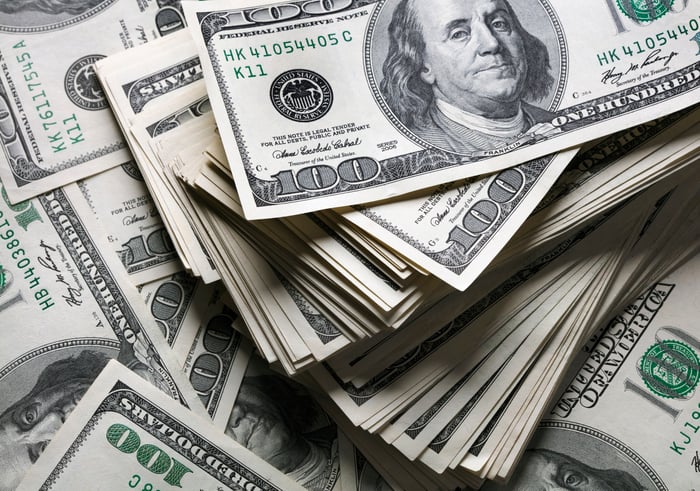Change is one of Wall Street's few constants. Due to a combination of corporate innovation, collaboration, competition, and acquisitions, the largest publicly traded companies in the U.S. are regularly in flux.
Looking back to the start of this century, just one company, Microsoft (MSFT 1.82%), remains on today's list of the 10 largest stocks by market cap.
As of this past weekend, five stocks were officially part of the exclusive trillion-dollar club:
- Apple (AAPL -0.35%)
- Microsoft
- Alphabet (GOOGL 10.22%) (GOOG 9.96%)
- Amazon (AMZN 3.43%)
- Nvidia (NVDA 6.18%)

Image source: Getty Images.
What these companies share is true industry-leading dominance. They have a history of generating significant cash flow, and possess virtually impenetrable moats, at least in some respects.
- Apple currently accounts for around half of all U.S. smartphone market share.
- Microsoft's legacy Windows operating system still dominates the personal-computing space.
- Alphabet's global internet search market share, via Google, hasn't fallen below 90% in over eight years.
- Amazon was estimated to have brought in just shy of 40% of all U.S. retail online sales in 2022, per eMarketer.
- Nvidia commands the lion's share of graphics processing units being used in data centers to power artificial-intelligence driven software and systems.
In short, there are reasons these five companies have hit the elusive trillion-dollar mark. The big question is: Which stocks are next to join them?
Three unique stocks aiming for a trillion-dollar market cap
While the expected answer might be electric vehicle manufacturer Tesla (TSLA -1.11%) or social media stock Meta Platforms (META 0.43%), I'm not going the easy route. Both companies previously had trillion-dollar market caps and fell from grace. Rather, I'm looking for stocks that would be brand-new members of the trillion-dollar club, and three come to mind.
Berkshire Hathaway: Current market cap of $740 billion
The stock that seems the likeliest to reach the trillion-dollar market cap plateau the soonest is conglomerate Berkshire Hathaway (BRK.A -0.76%) (BRK.B -0.69%). This is the company that's been headed by billionaire investor extraordinaire Warren Buffett since the mid-1960s.
"Past performance is no guarantee of future results," is one of the best-known phrases on Wall Street. Though Berkshire's past gains could be difficult to duplicate, Buffett's company has doubled-up the annualized total return, including dividends, of the S&P 500 over a nearly six-decade stretch -- 19.8% for Berkshire's Class A shares (BRK.A) versus 9.9% for the S&P 500. Historically speaking, counting on Buffett to outperform Wall Street has been a relatively safe bet for decades.
One of the primary reasons Berkshire Hathaway has been such a phenomenal investment for over a half-century is Buffett's love of cyclical companies -- i.e., companies that ebb and flow with the U.S. economy. Instead of trying to time when the U.S. economy or stock market will run into inevitable rough patches, the Oracle of Omaha has packed his company's investment portfolio and its owned assets with cyclical businesses. It's a smart move, because periods of expansion last much longer than recessions. This allows Berkshire Hathaway to take advantage of multiyear bull markets.
Buffett is also a big-time fan of dividend stocks. Earlier this year, I calculated that Berkshire would collect more than $6 billion in dividend income in 2023. Companies that pay a regular dividend are almost always profitable, have clear long-term outlooks, and tend to be time-tested.
And income stocks have absolutely crushed non-dividend stocks in the return department over the long run. A study from J.P. Morgan Asset Management, a division of banking giant JPMorgan Chase, found that companies initiating and growing their payouts between 1972 and 2012 generated an average annual return of 9.5%. Meanwhile, stocks that didn't pay dividends trudged to annualized gains of just 1.6% over the same 40-year period.
Visa: Current market cap of $479 billion
A second stock that has realistic trillion-dollar ambitions is none other than payment-processing kingpin Visa (V -0.23%).
One of the core reasons Visa is such a successful business is the same as why Berkshire Hathaway has handily outperformed Wall Street for more than a half-century: the length of economic expansions. Even though Visa is cyclical, and will therefore be hurt in the short term by reduced consumer and enterprise spending during recessions, expansions are usually measured in years (note the plural).
In other words, Visa is spending a disproportionate amount of time benefiting from bull markets and a growing U.S. and global economy than it does navigating a challenging economy.
IIt certainly doesn't hurt that Visa is the payment-processing leader in the U.S., the largest market for consumption globally. Based on the 2021 annual filings from the four biggest payment processors, Visa accounted for almost 53% of credit-card network purchase volume in the United States. What's more, it was the only one of the four major payment processors to gain meaningful share following the Great Recession in 2007-2009.
But there's also ample opportunity for Visa to shine internationally. The Middle East, Africa, and Southeast Asia are largely underbanked regions, and a significant percentage of global transactions are still being conducted with cash. Visa has the financial capacity to expand into these regions organically, or it could turn to acquisitions to expedite its expansion efforts. Its overseas potential is what could allow the company to sustain double-digit annual growth throughout this decade, if not well beyond.

Image source: Getty Images.
PayPal Holdings: Current market cap of $74 billion
The third stock that's a solid bet to eventually join the trillion-dollar club (but one that will undoubtedly need a little more time than Berkshire Hathaway and Visa) is fintech leader PayPal Holdings (PYPL 2.90%).
At one point roughly two years ago, PayPal was about a third of the way to becoming a trillion-dollar company. Unfortunately, the wheels came off the bus.
The 2022 bear market chopped down growth stocks with premium valuations. And historically high inflation threatened to reduce the purchasing power of low-earning consumers. Since PayPal is a usage-driven digital payment network, fewer transactions aren't a good thing.
But in spite of two quarters of negative gross domestic product growth in the U.S. to start 2022, as well as an assortment of worrisome economic indicators, PayPal's key performance metrics continue moving in the right direction.
For instance, total payment volume traversing its networks (predominantly PayPal and Venmo) has consistently grown by a low double-digit percentage, excluding currency movements. That's phenomenal considering the earnings weakness we've seen from other high-growth industries.
Even more noteworthy is that PayPal's active customer engagement is meaningfully increasing. At the close of 2020, active accounts were completing an average of 40.9 transactions over the trailing 12 months (TTM). As of the end of March 2023, active accounts were completing an average of 53.1 transactions over the TTM. Digital payments are still in their infancy, and what we're seeing is that early adopters are really latching on to this payment technology.
PayPal was pretty consistently growing its sales by around 20% on an annual basis before its recent slowdown. Given the global potential for fintech solutions worldwide, an expansion back to 15% to 20% annual revenue growth seems perfectly doable. If that were to happen, PayPal could have a real shot at joining the trillion-dollar club before the end of the decade.





